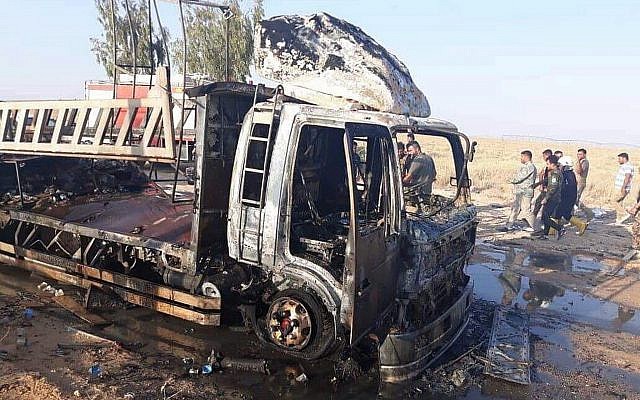Aftermath of a drone attack in western Iraq, near the Qaim border crossing with Syria, August 25, 2019 (Popular Mobilization Forces)
Israel has been accused of strikes on Iran-backed militia on the border between eastern Syria and Iraq, paralleling attacks on Iran, Hezbollah, and other Iran-supported units elsewhere in the country.
On Sunday, a drone strike in town of al-Qaim in western Iraq, about 15 km (10 miles) from the border, killed a militia commander of the Popular Mobilization Forces’ Brigade 15. One fighter was severely wounded.
PMF officials said the attack was by two drones on vehicles transporting weapons. One official said the commander, Kazem Mohsen, was a member of the militia’s rocket squad. He added that Mohsen had fought in Syria and had been detained by US forces.
The Fatah Coalition, an influential bloc in the Iraqi Parliament, said it held the US responsible for the Israeli attacks, “a declaration of war on Iraq and its people”.
Since July 19, there have been three other explosions at the PMF’s bases. The first killed two Iranian citizens in Amerli in northern Iraq, about 100 km (62 miles) from the Iran border. The second on July 28 was at weapons storage sites in Camp Ashraf, 40 km (25 miles) north of Baghdad.
On August 12, an apparent strike detonated an ammunition warehouse in a complex in southern Baghdad, setting off hundreds of mortars and rockets with debris scattered up to 5 km (3 miles) away. One person was killed and 29 wounded.
The PMF was organized in 2014, with Iranian support, from Shia armed groups and volunteers to fight the Islamic State , which had seized about 1/3 of Iraq in a lightning offensive.
It now operates officially under Iraq’s armed forces, but Brigade 45 is one of made up of fighters from Kataib Hezbollah , designated by the US as a “foreign terrorist organization”.
Linked Israeli Operations Across the Region
Israel has carried out hundreds of airstrikes against Assad regime, Iranian, and Hezbollah targets during Syria’s 101-month conflict. The attacks initially focused on Iranian transfers of weapons and missiles to Hezbollah and on the movement of Iranian and Hezbollah personnel to southwest Syria near the Israeli-occupied Golan Heights, and expanded across the country in the past 18 months as Prime Minister Benjamin Netanyahu demanded complete Iranian military withdrawal.
In the past six weeks, the attacks appear to have been linked to strikes in Iraq and Lebanon. On Saturday night, Israeli missiles hit an Iranian-operated complex in Aqrabah, near Syria’s capital Damascus, killing two Hezbollah members. The Israeli Defense Forces said the center was directing a “plot” for imminent drone strikes inside Israel.
Almost at the same time, Hezbollah said one Israeli drone attacked its media center in south Beirut, and another landed without detonating. Lebanese Prime Minister Saad Hariri criticized Israeli violation of Lebanese airspace as “aggressive intentions and [Israel’s] targeting of stability and peace in Lebanon and the region”.
Hezbollah leader Hassan Nasrallah pointed to an expansion of conflict, in a Sunday speech to supporters: “The era when Israeli war jets were able to strike targets in Lebanon while [Israel] is kept safe has ended…Wait for our response which may take place at any time on the borders and beyond the borders.”
The commander of Iran’s Quds Forces, the Revolutionary Guards branch operating outside the country, proclaimed the end of the Israeli Government.
“There is no doubt that these insane operations will be the last struggles of the Zionist regime,” Major General Qassem Soleimani said.

